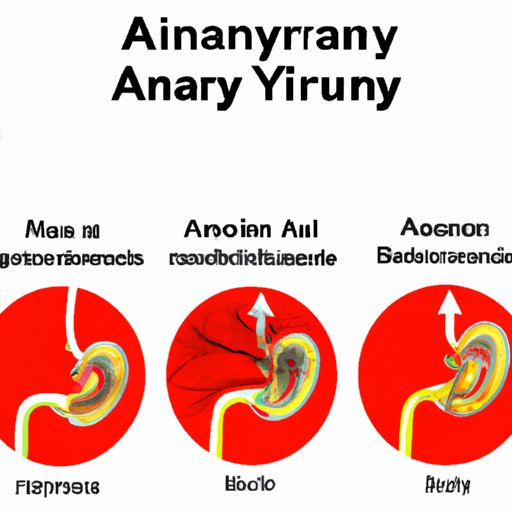
Introduction
An aneurysm is a serious medical condition that occurs when the wall of a blood vessel becomes weakened and bulges out. Aneurysms can occur anywhere in the body, but they are commonly found in the brain and abdomen. An aneurysm can rupture and cause severe bleeding, leading to a life-threatening condition. It is crucial to know the symptoms of an aneurysm to prevent a rupture and seek immediate medical help.
The Silent Killer: Understanding the Symptoms of Aneurysms
An aneurysm is commonly known as a silent killer because it can be asymptomatic for an extended period, even up to several years, until it ruptures. Moreover, there are hardly any signs of an imminent rupture. However, there are certain symptoms that can be observed and reported as early warnings of an aneurysm.
It is essential to understand the symptoms of an aneurysm to detect them early and prevent a rupture. Early detection of an aneurysm can make a significant difference in treating the condition and saving a life.
Don’t Ignore these Signs and Symptoms of an Aneurysm
Aneurysms in the brain can present various signs and symptoms, including:
Headaches
Headaches are often the first symptom of an aneurysm, especially if it is located in the brain. A severe headache that comes on suddenly is known as a thunderclap headache. In some cases, it can be followed by nausea and vomiting.
Visual disturbances
An aneurysm that presses on the optic nerve can cause visual disturbances, such as blurred or double vision.
Pain above or behind the eye
Aneurysms in the brain can cause pain around the eye area, which can be sudden and severe.
Dilated pupils
In some cases, an aneurysm can put pressure on the nerves that control the pupil’s size, causing one or both the pupils to enlarge.
Neck pain or stiffness
Aneurysms that cause bleeding in the brain can cause stiffness in the neck and shoulders.
Loss of consciousness
A ruptured aneurysm can cause loss of consciousness, which is an emergency that requires immediate medical attention.
Spotting the Warning Signs: Symptoms of Aneurysms
Aneurysms that rupture can cause life-threatening symptoms such as:
Sudden severe headache
A ruptured aneurysm causes a sudden and severe headache that is often described as the worst headache of one’s life. This headache is an emergency that requires immediate medical attention.
Nausea and vomiting
A ruptured aneurysm can cause nausea and vomiting, which can be sudden and severe.
Seizure
A ruptured aneurysm can cause a seizure, which is a medical emergency.
Confusion or disorientation
A ruptured aneurysm can cause confusion or disorientation, which can be sudden and severe.
Sensitivity to light
A ruptured aneurysm can cause sensitivity to light, known as photophobia.
Numbness or weakness
A ruptured aneurysm can cause numbness or weakness, which can affect one side of the body or limb.
Aneurysm Symptoms: What You Need to Know to Stay Safe
Certain risk factors increase the likelihood of developing an aneurysm. These include:
Age and gender risk factors
Women over 40 years of age and men over 55 years of age are at higher risk of developing an aneurysm.
Medical history risk factors
A family history of aneurysms, hypertension, and atherosclerosis can increase the risk of developing an aneurysm.
Lifestyle risk factors
Smoking, excessive alcohol consumption, drug abuse, and a sedentary lifestyle can increase the risk of developing an aneurysm.
Genetic risk factors
Certain genetic disorders, such as Marfan Syndrome and Polycystic Kidney Disease, can increase the risk of developing an aneurysm.
It is vital to talk to a doctor if you have any of these risk factors or experience any symptoms.
From Headaches to Vision Changes: Recognizing Symptoms of Aneurysms
In addition to the general symptoms mentioned earlier, an aneurysm can cause specific symptoms based on its location. These include:
Speech problems or difficulty speaking
An aneurysm that affects the speech center in the brain can cause speech problems or difficulty speaking.
Personality changes
An aneurysm that affects the behavioral center in the brain can cause personality changes, including aggression, depression, and anxiety.
Balance problems
An aneurysm that affects the cerebellum can cause balance problems and difficulty walking.
Seizures
An aneurysm that affects the temporal lobe in the brain can cause seizures.
Hearing loss or ringing in the ears
An aneurysm that affects the inner ear can cause hearing loss or ringing in the ears.
It is essential to know your body and seek medical help immediately if you experience any of these symptoms.
Stay Ahead of the Game: Early Warning Signs of Aneurysms to Watch For
Early warning signs of an aneurysm include:
Pain in the back, chest, or abdomen
Aneurysms that occur in the aorta (the largest artery in the body) can cause pain in the back, chest, or abdomen.
Cold feet or hands
Aneurysms that occur in the peripheral arteries can cause cold feet or hands.
Swelling in the legs
Aneurysms that occur in the peripheral arteries can cause swelling in the legs.
Inability to tolerate exercise
Aneurysms that occur in the arteries can cause shortness of breath, fatigue, and inability to tolerate exercise.
It is crucial to alert a doctor immediately if you experience any of these warning signs.
Conclusion
It is essential to be aware of the symptoms of an aneurysm, which can be life-threatening if left untreated. Early detection of an aneurysm can make a significant difference in treating the condition and saving a life. If you have any risk factors or experience any symptoms, speak to your doctor immediately to seek medical help. Remember, don’t ignore the warning signs; they could save your life.




